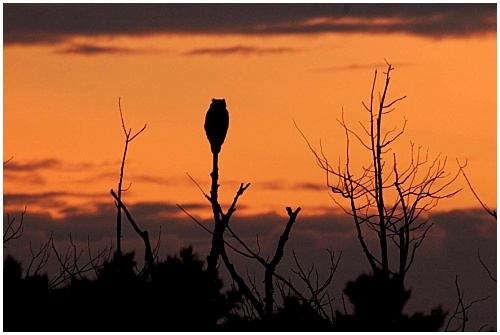March 19, 2020 at 4:00 pm

What to Atlas in March:
Owls
Great Horned Owls start nesting in midwinter so any acceptable codes you detect should be reported. Keep an ear open at night for their Whos awake? Me too songs that are often duetted between pairs. A careful ear will even be able to detect differences in the females higher pitched vocalizations compared to the males lower, deeper hoots. Eastern Screech-Owls are still a rare enough species that even observed reports will require documentation but they have historically bred in Maine so it'd be great to get a confirmed record during the period of this atlas. Mid-March gets us into the safe dates for Barred Owls but we've still got a couple more weeks for Northern Saw-whet Owls to be put into the atlas portal.
Some Other Raptors
Bald Eagle safe dates begin on March 16th although some nests have already been documented as occupied this year. Now is a great time to visit a local nest you know of to see if a pair has returned this year. Safe dates for Peregrine Falcons begin a little later this month, on March 25th, but you can keep an eye out for breeding behavior at known sites like the Casco Bay Bridge (Cumberland County), the Precipice Trail at Acadia NP (Hancock County), or the Veterans Remembrance Bridge in Brewer (Penobscot County). Some Red-shouldered Hawks are just returning to Maine in March while others have overwintered, these migrants push our safe dates back to May 15th but keep an eye on those resident birds: reports of pairs copulating and building nests have come in this March!
Invasives Count
Non-Native species like Rock Pigeons and Horse Sparrows are just as important to document during this atlas as any other species. Both of these species have safe dates beginning on March 1st and it is even possible to find them nesting around cities early than this. Rock Pigeon chicks were found during February in 2020!
Gray Jays
Slightly more charismatic than pigeons, our endearing Gray Jays of Maines boreal habitats are also starting to nest. Their safe dates begin on March 25th so see if you can catch one of these famous camp robbers gathering nesting material.
American Woodcocks
With a warm February we saw a push of American Woodcocks streaming north into Maine and a few people have even heard them peenting at night. We are still outside of the safe date for woodcocks so it is too early to report a woodcock that is only peenting because they are still migrating through (once in the safe dates, this would be coded as S for singing.) If you do observer a woodcock doing its full aerial display, that can be submitted outside of the safe dates using C for courtship.
Red and White-winged crossbills
The abundant cone crops are setting up crossbills for an early nesting season! Crossbills are known as opportunistic breeders because food availability is the primary factor in timing of breeding for most of their populations. There was a large movement of White-winged Crossbills into the northeast this winter, and decent numbers of Reds being reported as well. Perhaps not a surprise following our January report where White-winged Crossbills were seen doing breeding displays, a chick was found near Moosehead during the first week of March.
A few cautions in March:
As with all records, we want to make sure that only checklists that include a breeding code are submitted to the Maine Bird Atlas portal. However, any Possible Breeding Codes (S, H) MUST be within the safe dates for those species. Please be sure to read the Volunteer Handbook and review the Breeding Bird Evidence Codes PDFs on the atlas Resources and Materials page before submitting records to the Maine Bird Atlas Portal. These records can still be submitted to the Maine eBird Portal, with all your other birding efforts.
- 588